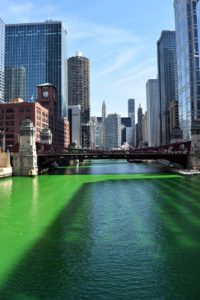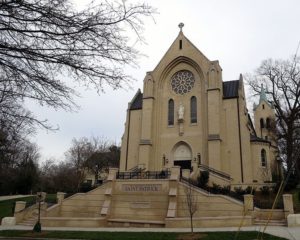St. Patrick’s Trivia Challenge
 St. Patrick’s Day has never been on my radar to any great extent, but for some reason I became curious this year as to who St. Patrick really was. A search of the internet yielded a very interesting article by Stephen Nichols that shed some light on my quest. As I read it, I was intrigued; and I decided to play my own version of Trivial Pursuit with my family at Sunday lunch.
St. Patrick’s Day has never been on my radar to any great extent, but for some reason I became curious this year as to who St. Patrick really was. A search of the internet yielded a very interesting article by Stephen Nichols that shed some light on my quest. As I read it, I was intrigued; and I decided to play my own version of Trivial Pursuit with my family at Sunday lunch.
Just as I suspected, they didn’t know much about the famous subject of our annual holiday either. Perhaps you’d like to play as well and see how much you know about church history. The first question is an easy one if you pay attention to the news. The answers are at the end. You may want a sheet of paper and a pen. There are 17 questions. Just answer each statement with True or False. No peeking!
- On St. Patrick’s Day, the city of Boston dumps 40 pounds of green dye into the river to turn the water green.
- Patrick was born in 385 in Roman Britannia in the modern-day town of Dumbarton, Scotland.
- Patrick wrote an autobiography called Confession.
- Patrick’s father was a deacon, and his grandfather was a priest in the Catholic Church.
- At 16 Patrick was captured by Irish pirates and taken to Ireland where he worked as a shepherd and farm laborer.
- When he was about 23, Patrick had a vision or vivid dream that revealed a secret plan to help him escape.
- Patrick fled his captors and reached a British ship in the harbor that took him home.
- His experience as a prisoner in Ireland transformed his faith, and he became a priest.
- Burdened for the people of Ireland, Patrick returned to the place where he was held captive to witness to the pagans.
- This time, though, Patrick carried a dagger to protect himself.
- After hearing Patrick speak, the king was converted and baptized resulting in much of Ireland following suit.
- Patrick rid Ireland of snakes.
- Patrick’s witness led to a transformation of Ireland from barbarism to a whole new ethic.
- Patrick planted his first of many churches at Saul.
- Patrick used the shamrock to teach the Irish about the Trinity.
- Patrick was canonized by the Catholic Church in 1255.
- Patrick composed a lorica—a prayer—we now call St. Patrick’s Breastplate.
- St. Patrick’s Cathedral is in Charlotte, North Carolina.
O.K. Let’s see how you did.
All of the statements are true except 1, 12, 15, 16, and 18. 
(1) The city of Chicago, not Boston, dumps green dye in the river on St. Patrick’s Day. As a part of more than a fifty-year-old tradition, the Chicago River is dyed green in observance of St. Patrick’s Day. The tradition actually began by accident when Mayor Richard Daley authorized plumbers to use fluorescein dye to trace sources of illegal pollution discharges.
(12) Patrick did not rid Ireland of snakes as snakes were not native to the country at the time.
(15) Although legend has it that Patrick used shamrocks to teach people about the Trinity, there is no evidence of that being the case.
(16) Patrick was never canonized in the Catholic church. He did minister as a priest from his early 20’s for the rest of his life.
 (18) There is a St. Patrick’s Cathedral in Charlotte, North Carolina. Apparently it is a common name for churches around the world. The one in Charlotte is actually the mother church of the Diocese of Charlotte.
(18) There is a St. Patrick’s Cathedral in Charlotte, North Carolina. Apparently it is a common name for churches around the world. The one in Charlotte is actually the mother church of the Diocese of Charlotte.
Well, how did you do?
Now, you may be saying to yourself, “So what? What difference does this make to me?”
Well, Catholic or Protestant, I think we can learn much from St. Patrick.
First, our faith often grows strongest during times of great difficulty.
“Dear brothers and sisters, when troubles of any kind come your way, consider it an opportunity for great joy. For you know that when your faith is tested, your endurance has a chance to grow.” (James 1:2-3 NLT)
Second, though none of us has ever experienced physical slavery like Patrick, we can become slaves to all kinds of things—drugs, alcohol, sex, money, possessions, etc. As we turn to the Lord to free us from bondage, we, like Patrick, can find a way out of our distress through Jesus Christ.
“That’s why I take pleasure in my weaknesses, and in the insults, hardships, persecutions, and troubles that I suffer for Christ. For when I am weak, then I am strong.” (2 Corinthians 12:10 NLT)
Third, if we follow Jesus’ teachings, we are to forgive those who hurt us just as Patrick did.
“You have heard the law that says the punishment must match the injury: ‘An eye for an eye, and a tooth for a tooth.’ But I say, do not resist an evil person! If someone slaps you on the right cheek, offer the other cheek also. If you are sued in court and your shirt is taken from you, give your coat, too.” (Matthew 5:38-40 NLT)
Fourth, despite the abuse he suffered, Patrick took very seriously Jesus’ Great Commission:
“Therefore, go and make disciples of all the nations, baptizing them in the name of the Father and the Son and the Holy Spirit. Teach these new disciples to obey all the commands I have given you. And be sure of this: I am with you always, even to the end of the age.” (Matthew 28:19-20 NLT)
Fifth, because of his faithfulness, the Lord blessed his ministry immensely. Patrick was like the faithful servant who used his master’s resources wisely; and he was, no doubt, blessed for his obedience and faithfulness.
“The master said, ‘Well done, my good and faithful servant. You have been faithful in handling this small amount, so now I will give you many more responsibilities. Let’s celebrate together!’ (Matthew 25:23 NLT)
Finally, as we reflect on the life of St. Patrick, perhaps we should remember his lorica—a prayer recited for protection–which was sometimes written out and placed on the shields of soldiers:
Christ with me,
Christ before me,
Christ behind me,
Christ in me,
Christ beneath me,
Christ above me,
Christ on my right,
Christ on my left,
Christ when I lie down,
Christ when I sit down,
Christ when I arise,
Christ in the heart of every man who thinks of me,
Christ in the mouth of everyone who speaks of me,
Christ in every eye that sees me,
Christ in every ear that hears me.
Well, what about you? Ever thought much about St. Patrick? With names in my family tree like McGinnis and Ramsey, Beason and Tate, I have roots in Scotland, Ireland, and England; and I think it is a good thing to learn something of the Christianization of my ancestors’ homeland. One day, I would like to travel there.
Anyone out there well acquainted with the truth about St. Patrick? If so, please write and share your stories. I’d love to hear from you!
*Source: “Who was Saint Patrick and Should Christians Celebrate St. Patrick’s Day? From Stephen Nichols, March 15, 2019, Category: Articles